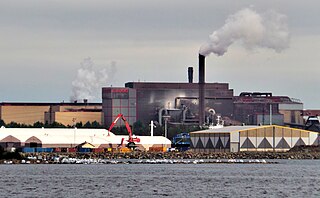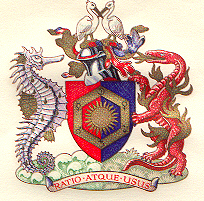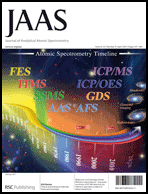
Analytical chemistry studies and uses instruments and methods to separate, identify, and quantify matter. In practice, separation, identification or quantification may constitute the entire analysis or be combined with another method. Separation isolates analytes. Qualitative analysis identifies analytes, while quantitative analysis determines the numerical amount or concentration.
Chemometrics is the science of extracting information from chemical systems by data-driven means. Chemometrics is inherently interdisciplinary, using methods frequently employed in core data-analytic disciplines such as multivariate statistics, applied mathematics, and computer science, in order to address problems in chemistry, biochemistry, medicine, biology and chemical engineering. In this way, it mirrors other interdisciplinary fields, such as psychometrics and econometrics.

The Royal Society of Chemistry (RSC) is a learned society in the United Kingdom with the goal of "advancing the chemical sciences". It was formed in 1980 from the amalgamation of the Chemical Society, the Royal Institute of Chemistry, the Faraday Society, and the Society for Analytical Chemistry with a new Royal Charter and the dual role of learned society and professional body. At its inception, the Society had a combined membership of 34,000 in the UK and a further 8,000 abroad. The headquarters of the Society are at Burlington House, Piccadilly, London. It also has offices in Thomas Graham House in Cambridge where RSC Publishing is based. The Society has offices in the United States, on the campuses of The University of Pennsylvania and Drexel University, at the University City Science Center in Philadelphia, Pennsylvania, in both Beijing and Shanghai, China and in Bangalore, India.

Environmental chemistry is the scientific study of the chemical and biochemical phenomena that occur in natural places. It should not be confused with green chemistry, which seeks to reduce potential pollution at its source. It can be defined as the study of the sources, reactions, transport, effects, and fates of chemical species in the air, soil, and water environments; and the effect of human activity and biological activity on these. Environmental chemistry is an interdisciplinary science that includes atmospheric, aquatic and soil chemistry, as well as heavily relying on analytical chemistry and being related to environmental and other areas of science.

The Royal Institute of Chemistry was a British scientific organisation. Founded in 1877 as the Institute of Chemistry of Great Britain and Ireland (ICGBI), its role was to focus on qualifications and the professional status of chemists, and its aim was to ensure that consulting and analytical chemists were properly trained and qualified.

ChemComm, formerly known as Journal of the Chemical Society D: Chemical Communications (1969–1971), Journal of the Chemical Society, Chemical Communications (1972–1995), is a peer-reviewed scientific journal published by the Royal Society of Chemistry. It covers all aspects of chemistry. In January 2012, the journal moved to publishing 100 issues per year. The current chair of the editorial board is Douglas Stephan, while the executive editor is Richard Kelly.

Analytical Chemistry is a biweekly peer-reviewed scientific journal published since 1929 by the American Chemical Society. Articles address general principles of chemical measurement science and novel analytical methodologies. Topics commonly include chemical reactions and selectivity, chemometrics and data processing, electrochemistry, elemental and molecular characterization, imaging, instrumentation, mass spectrometry, microscale and nanoscale systems, -omics, sensing, separations, spectroscopy, and surface analysis. It is abstracted and indexed in Chemical Abstracts Service, CAB International, EBSCOhost, ProQuest, PubMed, Scopus, and the Science Citation Index Expanded. According to the Journal Citation Reports, it has a 2020 impact factor of 6.986. The editor-in-chief is Jonathan V. Sweedler.

Richard Neil Zare is the Marguerite Blake Wilbur Professor in Natural Science and a Professor of Chemistry at Stanford University. Throughout his career, Zare has made a considerable impact in physical chemistry and analytical chemistry, particularly through the development of laser-induced fluorescence (LIF) and the study of chemical reactions at the molecular and nanoscale level. LIF is an extremely sensitive technique with applications ranging from analytical chemistry and molecular biology to astrophysics. One of its applications was the sequencing of the human genome.

Inorganic Chemistry is a biweekly peer-reviewed scientific journal published by the American Chemical Society since 1962. It covers research in all areas of inorganic chemistry.

Analyst is a biweekly peer-reviewed scientific journal covering all aspects of analytical chemistry, bioanalysis, and detection science. It is published by the Royal Society of Chemistry and the editor-in-chief is Norman Dovichi. The journal was established in 1877 by the Society for Analytical Chemistry.

The Journal of Analytical Atomic Spectrometry is a peer-reviewed scientific journal publishing original (primary) research and review articles covering all areas of modern spectrometry including fundamental theory, practice and analytical applications. It is published monthly by the Royal Society of Chemistry, the editor-in-chief is May Copsey. The journal replaced Annual Reports on Analytical Atomic Spectroscopy (1971–1984) in 1986 and has a 2021 impact factor of 4.351. The current editor-in-chief is Heidi Goenaga-Infante (LGC).

The Journal of Chromatography A is a peer-reviewed scientific journal publishing research papers in analytical chemistry, with a focus on techniques and methods used for the separation and identification of mixtures. The major difference between Journal of Chromatography A and Journal of Chromatography B is the focus being on preparative chromatography instead of analytical chromatography. The split of the Journal of Chromatography into two journals occurred in late 1993, with volume 652 being the first for Journal of Chromatography A.
Robert Graham Cooks is the Henry Bohn Hass Distinguished Professor of Chemistry in the Aston Laboratories for Mass Spectrometry at Purdue University. He is an ISI Highly Cited Chemist, with over 1,000 publications and an H-index of 144.

The Annual Review of Analytical Chemistry is a peer-reviewed academic journal that publishes an annual volume of review articles relevant to analytical chemistry. It was established in 2008 and is published by Annual Reviews.

Allen Joseph Bard is an American chemist. He is the Hackerman-Welch Regents Chair Professor and director of the Center for Electrochemistry at the University of Texas at Austin. Bard is considered a "father of modern electrochemistry" for his innovative work developing the scanning electrochemical microscope, his co-discovery of electrochemiluminescence, his key contributions to photoelectrochemistry of semiconductor electrodes, and co-authoring a seminal textbook.
Analytical and Bioanalytical Chemistry is a peer-reviewed scientific journal publishing research articles in the broad field of analytical and bioanalytical chemistry. Some of the subjects covered are the development of instruments for mass spectrometry, metallomics, ionics, and the analytical characterization of nano- and biomaterials. The journal was first published in 1862 under the name Fresenius’ Journal of Analytical Chemistry. In 2002 the journal was renamed to Analytical and Bioanalytical Chemistry.

Analytica Chimica Acta is a peer-reviewed scientific journal published since 1947 that covers original research and reviews of fundamental and applied aspects of analytical chemistry.

Analytical Methods is a monthly peer-reviewed scientific journal covering research on the development of analytical techniques. It is published by the Royal Society of Chemistry and the editor-in-chief is Scott Martin.















